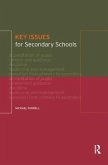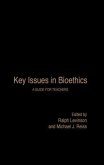Michael Farrell
Key Issues for Primary Schools
Michael Farrell
Key Issues for Primary Schools
- Gebundenes Buch
- Merkliste
- Auf die Merkliste
- Bewerten Bewerten
- Teilen
- Produkt teilen
- Produkterinnerung
- Produkterinnerung
This text gives a series of briefings on the main issues in primary education and the implications for schools. Presented in a handy A-Z format, readers can quickly find topics of immediate or particular interest.
Andere Kunden interessierten sich auch für
![Key Issues for Secondary Schools Key Issues for Secondary Schools]() Michael FarrellKey Issues for Secondary Schools160,99 €
Michael FarrellKey Issues for Secondary Schools160,99 €![Key Issues In Special Education Key Issues In Special Education]() Michael FarrellKey Issues In Special Education212,99 €
Michael FarrellKey Issues In Special Education212,99 €![Key Issues in Bioethics Key Issues in Bioethics]() Ralph Levinson / Michael Reiss (eds.)Key Issues in Bioethics177,99 €
Ralph Levinson / Michael Reiss (eds.)Key Issues in Bioethics177,99 €![Understanding Key Education Issues Understanding Key Education Issues]() Matthew LynchUnderstanding Key Education Issues108,99 €
Matthew LynchUnderstanding Key Education Issues108,99 €![Key Issues in Education Key Issues in Education]() Key Issues in Education121,99 €
Key Issues in Education121,99 €![Exploring Key Issues in Early Childhood and Technology Exploring Key Issues in Early Childhood and Technology]() Exploring Key Issues in Early Childhood and Technology169,99 €
Exploring Key Issues in Early Childhood and Technology169,99 €![Key Issues in Sustainable Development and Learning Key Issues in Sustainable Development and Learning]() Stephen Gough (ed.)Key Issues in Sustainable Development and Learning218,99 €
Stephen Gough (ed.)Key Issues in Sustainable Development and Learning218,99 €-
-
-
This text gives a series of briefings on the main issues in primary education and the implications for schools. Presented in a handy A-Z format, readers can quickly find topics of immediate or particular interest.
Produktdetails
- Produktdetails
- Verlag: Routledge
- Seitenzahl: 228
- Erscheinungstermin: 28. Juni 2017
- Englisch
- Abmessung: 240mm x 161mm x 17mm
- Gewicht: 511g
- ISBN-13: 9781138419643
- ISBN-10: 1138419648
- Artikelnr.: 48952589
- Herstellerkennzeichnung
- Libri GmbH
- Europaallee 1
- 36244 Bad Hersfeld
- gpsr@libri.de
- Verlag: Routledge
- Seitenzahl: 228
- Erscheinungstermin: 28. Juni 2017
- Englisch
- Abmessung: 240mm x 161mm x 17mm
- Gewicht: 511g
- ISBN-13: 9781138419643
- ISBN-10: 1138419648
- Artikelnr.: 48952589
- Herstellerkennzeichnung
- Libri GmbH
- Europaallee 1
- 36244 Bad Hersfeld
- gpsr@libri.de
Michael Farrell is an education inspector for the London Borough of Hillingdon. He trained as a teacher and psychologist and has been a head teacher and a lecturer at the Institute of Education.
Chapter 1 Admissions
Chapter 2 Appraisal
Chapter 3 Assessment Complexities
Chapter 4 Attendance
Chapter 5 Baseline Assessment
Chapter 6 Behaviour and its Improvement
Chapter 7 Benchmarking
Chapter 8 Bullying
Chapter 9 Child Protection
Chapter 10 Classroom Management
Chapter 11 Curriculum Changes
Chapter 12 Differentiation
Chapter 13 Direct Teaching
Chapter 14 Early Years
Chapter 15 Efficiency of the School and How it may be Improved
Chapter 16 Emotional and Behavioural Difficulties
Chapter 17 English as an Additional Language (EAL)
Chapter 18 Equal Opportunities
Chapter 19 Governing Bodies
Chapter 20 Group Work
Chapter 21 Head Teachers
Chapter 22 Health and Safety
Chapter 23 Homework
Chapter 24 Inclusion
Chapter 25 Information and Communications Technology
Chapter 26 Initial Teacher Training
Chapter 27 Inspection
Chapter 28 Learning Resources and their Full Use
Chapter 29 Literacy
Chapter 30 Marketing the Primary School
Chapter 31 Media Management for the School
Chapter 32 Numeracy
Chapter 33 Organisation of Pupils in School (Including Class Size)
Chapter 34 Parents and the Community
Chapter 35 Planning for Teaching and Learning
Chapter 36 Project Management in Primary Education
Chapter 37 Research
Chapter 38 School Improvement Plans Within Strategic Planning
Chapter 39 Security of the School
Chapter 40 Sex Education
Chapter 41 Spiritual, Moral, Social and Cultural Development
Chapter 42 Staff Development Including Newly Qualified Teachers
Chapter 43 Standards
Chapter 44 Support for Children
Chapter 45 Target Setting
Chapter 46 Teaching Assistants and Associates
Chapter 47 Topic Work as an Approach to the Curriculum
Chapter 48 Value Added Measures and their Relation to League Tables
Chapter 49 Very Able Pupils
Chapter 2 Appraisal
Chapter 3 Assessment Complexities
Chapter 4 Attendance
Chapter 5 Baseline Assessment
Chapter 6 Behaviour and its Improvement
Chapter 7 Benchmarking
Chapter 8 Bullying
Chapter 9 Child Protection
Chapter 10 Classroom Management
Chapter 11 Curriculum Changes
Chapter 12 Differentiation
Chapter 13 Direct Teaching
Chapter 14 Early Years
Chapter 15 Efficiency of the School and How it may be Improved
Chapter 16 Emotional and Behavioural Difficulties
Chapter 17 English as an Additional Language (EAL)
Chapter 18 Equal Opportunities
Chapter 19 Governing Bodies
Chapter 20 Group Work
Chapter 21 Head Teachers
Chapter 22 Health and Safety
Chapter 23 Homework
Chapter 24 Inclusion
Chapter 25 Information and Communications Technology
Chapter 26 Initial Teacher Training
Chapter 27 Inspection
Chapter 28 Learning Resources and their Full Use
Chapter 29 Literacy
Chapter 30 Marketing the Primary School
Chapter 31 Media Management for the School
Chapter 32 Numeracy
Chapter 33 Organisation of Pupils in School (Including Class Size)
Chapter 34 Parents and the Community
Chapter 35 Planning for Teaching and Learning
Chapter 36 Project Management in Primary Education
Chapter 37 Research
Chapter 38 School Improvement Plans Within Strategic Planning
Chapter 39 Security of the School
Chapter 40 Sex Education
Chapter 41 Spiritual, Moral, Social and Cultural Development
Chapter 42 Staff Development Including Newly Qualified Teachers
Chapter 43 Standards
Chapter 44 Support for Children
Chapter 45 Target Setting
Chapter 46 Teaching Assistants and Associates
Chapter 47 Topic Work as an Approach to the Curriculum
Chapter 48 Value Added Measures and their Relation to League Tables
Chapter 49 Very Able Pupils
Chapter 1 Admissions
Chapter 2 Appraisal
Chapter 3 Assessment Complexities
Chapter 4 Attendance
Chapter 5 Baseline Assessment
Chapter 6 Behaviour and its Improvement
Chapter 7 Benchmarking
Chapter 8 Bullying
Chapter 9 Child Protection
Chapter 10 Classroom Management
Chapter 11 Curriculum Changes
Chapter 12 Differentiation
Chapter 13 Direct Teaching
Chapter 14 Early Years
Chapter 15 Efficiency of the School and How it may be Improved
Chapter 16 Emotional and Behavioural Difficulties
Chapter 17 English as an Additional Language (EAL)
Chapter 18 Equal Opportunities
Chapter 19 Governing Bodies
Chapter 20 Group Work
Chapter 21 Head Teachers
Chapter 22 Health and Safety
Chapter 23 Homework
Chapter 24 Inclusion
Chapter 25 Information and Communications Technology
Chapter 26 Initial Teacher Training
Chapter 27 Inspection
Chapter 28 Learning Resources and their Full Use
Chapter 29 Literacy
Chapter 30 Marketing the Primary School
Chapter 31 Media Management for the School
Chapter 32 Numeracy
Chapter 33 Organisation of Pupils in School (Including Class Size)
Chapter 34 Parents and the Community
Chapter 35 Planning for Teaching and Learning
Chapter 36 Project Management in Primary Education
Chapter 37 Research
Chapter 38 School Improvement Plans Within Strategic Planning
Chapter 39 Security of the School
Chapter 40 Sex Education
Chapter 41 Spiritual, Moral, Social and Cultural Development
Chapter 42 Staff Development Including Newly Qualified Teachers
Chapter 43 Standards
Chapter 44 Support for Children
Chapter 45 Target Setting
Chapter 46 Teaching Assistants and Associates
Chapter 47 Topic Work as an Approach to the Curriculum
Chapter 48 Value Added Measures and their Relation to League Tables
Chapter 49 Very Able Pupils
Chapter 2 Appraisal
Chapter 3 Assessment Complexities
Chapter 4 Attendance
Chapter 5 Baseline Assessment
Chapter 6 Behaviour and its Improvement
Chapter 7 Benchmarking
Chapter 8 Bullying
Chapter 9 Child Protection
Chapter 10 Classroom Management
Chapter 11 Curriculum Changes
Chapter 12 Differentiation
Chapter 13 Direct Teaching
Chapter 14 Early Years
Chapter 15 Efficiency of the School and How it may be Improved
Chapter 16 Emotional and Behavioural Difficulties
Chapter 17 English as an Additional Language (EAL)
Chapter 18 Equal Opportunities
Chapter 19 Governing Bodies
Chapter 20 Group Work
Chapter 21 Head Teachers
Chapter 22 Health and Safety
Chapter 23 Homework
Chapter 24 Inclusion
Chapter 25 Information and Communications Technology
Chapter 26 Initial Teacher Training
Chapter 27 Inspection
Chapter 28 Learning Resources and their Full Use
Chapter 29 Literacy
Chapter 30 Marketing the Primary School
Chapter 31 Media Management for the School
Chapter 32 Numeracy
Chapter 33 Organisation of Pupils in School (Including Class Size)
Chapter 34 Parents and the Community
Chapter 35 Planning for Teaching and Learning
Chapter 36 Project Management in Primary Education
Chapter 37 Research
Chapter 38 School Improvement Plans Within Strategic Planning
Chapter 39 Security of the School
Chapter 40 Sex Education
Chapter 41 Spiritual, Moral, Social and Cultural Development
Chapter 42 Staff Development Including Newly Qualified Teachers
Chapter 43 Standards
Chapter 44 Support for Children
Chapter 45 Target Setting
Chapter 46 Teaching Assistants and Associates
Chapter 47 Topic Work as an Approach to the Curriculum
Chapter 48 Value Added Measures and their Relation to League Tables
Chapter 49 Very Able Pupils









